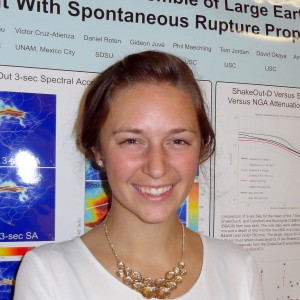Evolution of the Neogene Cacheuta Basin: A Record of Orogenic Exhumation and Basin Inversion in the south central Andes
Ellen Buelow
MS Candidate
Advisor: Dr. Dave Kimbrough
Thursday, May 5th, 2016
CSL 422 – 8:45am
watch Ellen’s defense
Abstract
The 7000 km long Andean orogen is a classic example of a convergent plate boundary continental margin magmatic arc. The high topography of the Andes, exceeding 6000 meters in the central and southern part, developed mostly in Late Cenozoic time driven eastwards propagation of east vergent fold-thrust belts. Flat slab segments are characterized by Laramide-style basement deformation that extends far inboard to the east within the continental relative to normal slab segments. Retroarc foreland basins bounding the fold-thrust belt to the east record orogenic exhumation and erosion of the Andes.
The Tertiary age ~2.2 km-thick Cachueta foreland basin sequence is located within the southern part of the Pampean flat-slab segment in the Central Andes of Argentina and Chile where the Juan Fernandez ridge is being subducted. Here, the Andes comprise a series of cordilleras that include from west to east the Coastal, Principal, Frontal, Precordillera and Sierra Pampeanas. The basin is divided into five distinct predominantly fluvial formations [Mariño, La Pilona, Tobas Angostura, Río de los Pozos, and Magotes]. Irigoyen et al (2000) provided a magnetic polarity timescale for the basin calibrated with 40Ar/39Ar ages in the upper part of the basin. This study provides new provenance data including sedimentary facies analysis, paleocurrent data, conglomerate clast counts, a large body of new detrital zircon U-Pb ages including data from intercalated tuff, as well as apatite (U-Th)/He low temperature thermochronologic data.
The new tuff zircon U-Pb ages combined with the youngest detrital zircon from sandstone forces a reinterpretation of the Irigoyen et al (2000) magnetostratigraphy shifting the basal age of the Marino Formation from ~15 Ma to ~20 Ma. A new correlation of magnetic reversal polarities is consistent with the revised age assignment. The new zircon U-Pb data also allows for evaluation of sedimentation rate through the Cachueta basin and show that rates abruptly double in the middle part of the basin sequence going from ~.16 mm/year in the Marino Formation to ~.33 mm/year in the overlying and distinctly coarser-grained La Pilona Formation. The Marino-Pilona contact is likely an unconformity of ~1 million years duration in the new chronostratigraphic framework provided here.
Conglomerate clast compositions shift abruptly going from the Marino to Pilona formations. The Marino is dominated by clasts derived from the Principal and Frontal cordilleras, while the Pilona Formation contains a distinct component of green lithic arenite sandstone/siltstone derived from the Precordillera (Villavicencio Formation). The distinct Marino vs Pilona provenance is also reflected by the ratio of Choiyoi (240-300 Ma) versus Grenville (950-1300 Ma) detrital zircon U-Pb ages which is higher in the Marino versus the Pilona strata reflect uplift and erosion of Precordillera basement starting around 11 Ma coincident the transition to Pampean flat-slab subduction.
The closure temperature for (U-Th)/He apatite ages is approximately 50°C. Apatite ages from the Marino Formation are mostly in the of 5-8 Ma range (ie., distinctly younger than depositional ages) which is interpreted to reflect basin inversion driven by thrust faulting as the basin transitioned from a foredeep to wedgetop basin setting. This transition is also represented by the arrival of very coarse-grained conglomeratic Magotes Formation strata.


